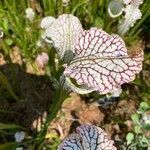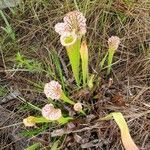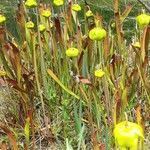Perennial herb to 1 m high, rhizomatous, forming dense clumps, producing new leaves each year. Carnivorous leaves: tubular 'pitchers', erect, hollow, widening towards opening at the apex, lower part of tube green, upper part white or whitish pink with distinct green to pink to reddish venation, glabrous or finely pubescent, the rim loosely revolute, often with an everted indentation forming a spout with a narrow wing running below outside of the tube, the operculum ('hood') wavy-or ruffled-edged, longer than wide, with downward-pointing hairs on the underside. Pitchers marcescent and can vary in size at different growth stages and during the year. Non-carnivorous leaves (phyllodia): flat, narrow to oblanceolate (to 20 cm or more long), green, may be produced in winter, when stressed or after flowering. Flowers solitary, borne on a long, slender, leafless stem, nodding, maroon to red or brownish red, slightly sweet-scented; sepals 5, petal-like, to 5 cm long, persistent; petals 5, hanging, to 5 (–7) cm long, distal portion orbiculate to rhombic, falling soon after flowering; style, including distinct style disc, umbrella-shaped, disc to 7 cm diam., reddish; stamens numerous. Capsule 5-parted, round, to 2 cm diam., warty, acropetally dehiscent, with numerous small seeds.




